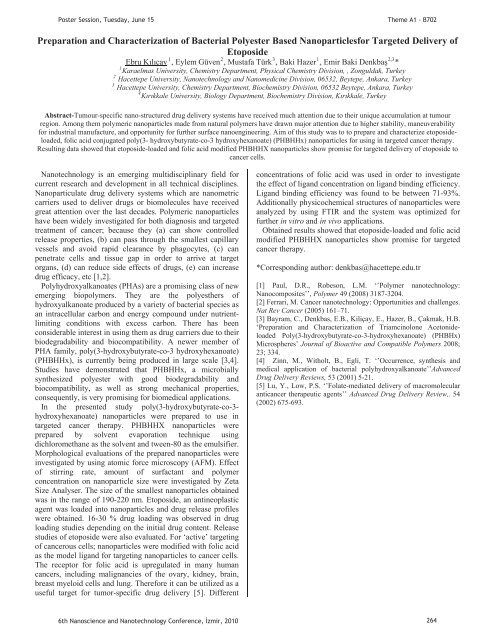Photonic crystals in biology
Photonic crystals in biology
Photonic crystals in biology
You also want an ePaper? Increase the reach of your titles
YUMPU automatically turns print PDFs into web optimized ePapers that Google loves.
P<br />
P<br />
P Hacettepe<br />
P Hacettepe<br />
P<br />
P<br />
Poster Session, Tuesday, June 15<br />
Theme A1 - B702<br />
Preparation and Characterization of Bacterial Polyester Based Nanoparticlesfor Targeted Delivery of<br />
Etoposide<br />
1<br />
2<br />
3<br />
1<br />
2,3<br />
UEbru KlçayUP P, Eylem GüvenP P, Mustafa TürkP P, Baki HazerP P, Emir Baki DenkbaP<br />
P*<br />
1<br />
2<br />
3<br />
PKaraelmas University, Chemistry Department, Physical Chemistry Division, , Zonguldak, Turkey<br />
University, Nanotechnology and Nanomedic<strong>in</strong>e Division, 06532, Beytepe, Ankara, Turkey<br />
University, Chemistry Department, Biochemistry Division, 06532 Beytepe, Ankara, Turkey<br />
4<br />
PKırıkkale University, Biology Department, Biochemistry Division, Kırıkkale, Turkey<br />
Abstract-Tumour-specific nano-structured drug delivery systems have received much attention due to their unique accumulation at tumour<br />
region. Among them polymeric nanoparticles made from natural polymers have drawn major attention due to higher stability, maneuverability<br />
for <strong>in</strong>dustrial manufacture, and opportunity for further surface nanoeng<strong>in</strong>eer<strong>in</strong>g. Aim of this study was to to prepare and characterize etoposideloaded,<br />
folic acid conjugated poly(3- hydroxybutyrate-co-3 hydroxyhexanoate) (PHBHHx) nanoparticles for us<strong>in</strong>g <strong>in</strong> targeted cancer therapy.<br />
Result<strong>in</strong>g data showed that etoposide-loaded and folic acid modified PHBHHX nanoparticles show promise for targeted delivery of etoposide to<br />
cancer cells.<br />
Nanotechnology is an emerg<strong>in</strong>g multidiscipl<strong>in</strong>ary field for<br />
current research and development <strong>in</strong> all technical discipl<strong>in</strong>es.<br />
Nanoparticulate drug delivery systems which are nanometric<br />
carriers used to deliver drugs or biomolecules have received<br />
great attention over the last decades. Polymeric nanoparticles<br />
have been widely <strong>in</strong>vestigated for both diagnosis and targeted<br />
treatment of cancer; because they (a) can show controlled<br />
release properties, (b) can pass through the smallest capillary<br />
vessels and avoid rapid clearance by phagocytes, (c) can<br />
penetrate cells and tissue gap <strong>in</strong> order to arrive at target<br />
organs, (d) can reduce side effects of drugs, (e) can <strong>in</strong>crease<br />
drug efficacy, etc [1,2].<br />
Polyhydroxyalkanoates (PHAs) are a promis<strong>in</strong>g class of new<br />
emerg<strong>in</strong>g biopolymers. They are the polyesthers of<br />
hydroxyalkanoate produced by a variety of bacterial species as<br />
an <strong>in</strong>tracellular carbon and energy compound under nutrientlimit<strong>in</strong>g<br />
conditions with excess carbon. There has been<br />
considerable <strong>in</strong>terest <strong>in</strong> us<strong>in</strong>g them as drug carriers due to their<br />
biodegradability and biocompatibility. A newer member of<br />
PHA family, poly(3-hydroxybutyrate-co-3 hydroxyhexanoate)<br />
(PHBHHx), is currently be<strong>in</strong>g produced <strong>in</strong> large scale [3,4].<br />
Studies have demonstrated that PHBHHx, a microbially<br />
synthesized polyester with good biodegradability and<br />
biocompatibility, as well as strong mechanical properties,<br />
consequently, is very promis<strong>in</strong>g for biomedical applications.<br />
In the presented study poly(3-hydroxybutyrate-co-3-<br />
hydroxyhexanoate) nanoparticles were prepared to use <strong>in</strong><br />
targeted cancer therapy. PHBHHX nanoparticles were<br />
prepared by solvent evaporation technique us<strong>in</strong>g<br />
dichloromethane as the solvent and tween-80 as the emulsifier.<br />
Morphological evaluations of the prepared nanoparticles were<br />
<strong>in</strong>vestigated by us<strong>in</strong>g atomic force microscopy (AFM). Effect<br />
of stirr<strong>in</strong>g rate, amount of surfactant and polymer<br />
concentration on nanoparticle size were <strong>in</strong>vestigated by Zeta<br />
Size Analyser. The size of the smallest nanoparticles obta<strong>in</strong>ed<br />
was <strong>in</strong> the range of 190-220 nm. Etoposide, an ant<strong>in</strong>eoplastic<br />
agent was loaded <strong>in</strong>to nanoparticles and drug release profiles<br />
were obta<strong>in</strong>ed. 16-30 % drug load<strong>in</strong>g was observed <strong>in</strong> drug<br />
load<strong>in</strong>g studies depend<strong>in</strong>g on the <strong>in</strong>itial drug content. Release<br />
studies of etoposide were also evaluated. For ‘active’ target<strong>in</strong>g<br />
of cancerous cells; nanoparticles were modified with folic acid<br />
as the model ligand for target<strong>in</strong>g nanoparticles to cancer cells.<br />
The receptor for folic acid is upregulated <strong>in</strong> many human<br />
cancers, <strong>in</strong>clud<strong>in</strong>g malignancies of the ovary, kidney, bra<strong>in</strong>,<br />
breast myeloid cells and lung. Therefore it can be utilized as a<br />
useful target for tumor-specific drug delivery [5]. Different<br />
concentrations of folic acid was used <strong>in</strong> order to <strong>in</strong>vestigate<br />
the effect of ligand concentration on ligand b<strong>in</strong>d<strong>in</strong>g efficiency.<br />
Ligand b<strong>in</strong>d<strong>in</strong>g efficiency was found to be between 71-93%.<br />
Additionally physicochemical structures of nanoparticles were<br />
analyzed by us<strong>in</strong>g FTIR and the system was optimized for<br />
further <strong>in</strong> vitro and <strong>in</strong> vivo applications.<br />
Obta<strong>in</strong>ed results showed that etoposide-loaded and folic acid<br />
modified PHBHHX nanoparticles show promise for targeted<br />
cancer therapy.<br />
*Correspond<strong>in</strong>g author: denkbas@hacettepe.edu.tr<br />
[1] Paul, D.R., Robeson, L.M. ‘’Polymer nanotechnology:<br />
Nanocomposites’’, Polymer 49 (2008) 3187-3204.<br />
[2] Ferrari, M. Cancer nanotechnology: Opportunities and challenges.<br />
Nat Rev Cancer (2005) 161–71.<br />
[3] Bayram, C., Denkbas, E.B., Kiliçay, E., Hazer, B., Çakmak, H.B.<br />
‘Preparation and Characterization of Triamc<strong>in</strong>olone Acetonideloaded<br />
Poly(3-hydroxybutyrate-co-3-hydroxyhexanoate) (PHBHx)<br />
Microspheres’ Journal of Bioactive and Compatible Polymers 2008;<br />
23; 334.<br />
[4] Z<strong>in</strong>n, M., Witholt, B., Egli, T. ‘’Occurrence, synthesis and<br />
medical application of bacterial polyhydroxyalkanoate’’Advanced<br />
Drug Delivery Reviews, 53 (2001) 5-21.<br />
[5] Lu, Y., Low, P.S. ‘’Folate-mediated delivery of macromolecular<br />
anticancer therapeutic agents’’ Advanced Drug Delivery Review,. 54<br />
(2002) 675-693.<br />
6th Nanoscience and Nanotechnology Conference, zmir, 2010 264













